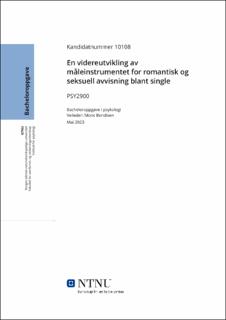| dc.contributor.advisor | Bendixen, Mons | |
| dc.contributor.advisor | Stavang, Marius | |
| dc.contributor.advisor | Kennair, Leif | |
| dc.contributor.author | Kvalvik, Therese | |
| dc.date.accessioned | 2023-07-11T17:19:55Z | |
| dc.date.available | 2023-07-11T17:19:55Z | |
| dc.date.issued | 2023 | |
| dc.identifier | no.ntnu:inspera:146342237:22418385 | |
| dc.identifier.uri | https://hdl.handle.net/11250/3077757 | |
| dc.description.abstract | Tema som omfatter denne studien er romantisk-seksuell avvisning blant single, hvor formålet er å videreutvikle et instrument som kan måle forekomst av avvisning. Problemstillingen ble utformet til «Hvilke underkomponenter har romantisk-seksuell avvisning, og i hvilken grad kan instrumentet anses reliabelt og valid?». Utgangspunktet for instrumentet er laget gjennom Act-Nomination prosedyrer av tidligere bachelorstudenter. Gjennom en Principal Component Analysis (PCA) med oblik rotasjonsmetode ble det ekstrahert tre underkomponenter som benevnes som diskré, ondsinnet og tydelig avvisning. Videre ble instrumentet nedskalert fra 54 til 14 testledd, fordelt på disse tre komponentene. Resultatet viste at instrumentet viste god indre konsistens, og dermed kunne anses reliabelt. Det ble påvist flere moderate og svake sammenhenger med validerende mål, som helhetlig møtte forventningene som ble satt ut i fra tidligere forskning. Likevel er det vanskelig å konkludere med at instrumentet kan regnes som valid da det trengs ytterligere videreutvikling og mer forskning som kan styrke validiteten. Implikasjoner til fremtidig forskning ble foreslått til å bruke instrumentet for å undersøke kjønnsforskjeller i avvisningserfaringer blant single og i større grad ta det digitale dating-markedet i betraktning. | |
| dc.description.abstract | The theme that this study addresses is romantic and sexual rejection among singles, with the aim of developing an instrument that can measure the occurrence of rejection. The research question was formulated as "What are the subcomponents of romantic and sexual rejection, and to what extent can the instrument be considered reliable and valid?" The instrument was developed based on Act-Nomination procedures conducted by former undergraduate students. A Principal Component Analysis (PCA) with an oblique rotation method extracted three subcomponents, which were labeled as discreet, malicious, and explicit rejection. The instrument was then scaled down from 54 to 14 items, distributed across these three subcomponents. The results showed that the instrument had good internal consistency and could thus be considered reliable. Several moderate and weak correlations were found with validating measures, which were consistent with previous research expectations. However, it is difficult to conclude that the instrument can be considered valid as further development and research are needed to strengthen its validity. Implications for future research were suggested, including using the instrument to investigate gender differences in rejection experiences among singles and taking the digital dating market into greater consideration. | |
| dc.language | nob | |
| dc.publisher | NTNU | |
| dc.title | Hvilke underkomponenter har romantisk-seksuell avvisning, og i hvilken grad anses instrumentet som reliabelt og valid? | |
| dc.type | Bachelor thesis | |
